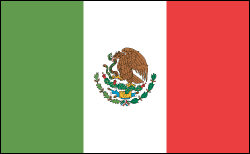Official name: Estados Unidos Mexicanos President: Enrique Pena Nieto (2012) Land Area: 742,485 sq mi (1,923,039 sq km); total area: 761,606 sq mi (1,972,550 sq km) Population (2014 est.): 120,286,655 (growth rate: 1.2%); birth rate: 19.02/1000; infant mortality rate: 12.58/1000; life expectancy: 75.4; density per sq mi: 145 Capital and largest city (2011 est.):Mexico City, 20,466,000 (metro. area), 8,681,400 (city proper) Other large cities (2011): Guadalajara, 4,525,000; Puebla, 2,335,000; Monterrey, 4,123,000 Monetary unit: Peso Languages: Spanish, various Mayan, Nahuatl, and other regional indigenous languages Ethnicity/race:mestizo (Indian-Spanish) 60%, Amerindian or predominantly Amerindian 30%, Caucasian or predominantly Caucasian 9%, other 1% Religions: nominally Roman Catholic 89%, Protestant 6%, other 5% Literacy rate: 92% (2003 est.) Economic summary: GDP/PPP (2005 est.): $1.068 trillion; per capita $10,100. Real growth rate: 3%. Inflation: 3.3%. Unemployment: 3.6% plus underemployment of perhaps 25%. Arable land: 13%. Agriculture: corn, wheat, soybeans, rice, beans, cotton, coffee, fruit, tomatoes; beef, poultry, dairy products; wood products. Labor force: 43.4 million; agriculture 18%, industry 24%, services 58% (2003). Industries: food and beverages, tobacco, chemicals, iron and steel, petroleum, mining, textiles, clothing, motor vehicles, consumer durables, tourism. Natural resources: petroleum, silver, copper, gold, lead, zinc, natural gas, timber. Exports: $213.7 billion f.o.b. (2005 est.): manufactured goods, oil and oil products, silver, fruits, vegetables, coffee, cotton. Imports: $223.7 billion f.o.b. (2005 est.): metalworking machines, steel mill products, agricultural machinery, electrical equipment, car parts for assembly, repair parts for motor vehicles, aircraft, and aircraft parts. Major trading partners: U.S., Canada, Spain, China, Japan (2004). Communications: Telephones: main lines in use: 12.332 million (2000); mobile cellular: 2.02 million (1998). Radio broadcast stations: AM 851, FM 598, shortwave 16 (2000). Radios: 31 million (1997). Television broadcast stations: 236 (plus repeaters) (1997). Televisions: 25.6 million (1997). Internet Service Providers (ISPs): 51 (2000). Internet users: 3.5 million (2002). Transportation: Railways: total: 19,510 km (2002). Highways: total: 329,532 km; paved: 108,087 km (including 6,429 km of expressways); unpaved: 221,445 km (1999 est.). Waterways: 2,900 km navigable rivers and coastal canals. Ports and harbors: Acapulco, Altamira, Coatzacoalcos, Ensenada, Guaymas, La Paz, Lazaro Cardenas, Manzanillo, Mazatlan, Progreso, Salina Cruz, Tampico, Topolobampo, Tuxpan, Veracruz. Airports: 1,823 (2002). International disputes: prolonged regional drought in the border region with the U.S. has strained water-sharing arrangements. |
 |
Geography
Mexico is bordered by the United States to the north and Belize and Guatemala to the southeast. Mexico is about one-fifth the size of the United States. Baja California in the west is an 800-mile (1,287-km) peninsula and forms the Gulf of California. In the east are the Gulf of Mexico and the Bay of Campeche, which is formed by Mexico's other peninsula, the Yucatán. The center of Mexico is a great, high plateau, open to the north, with mountain chains on the east and west and with ocean-front lowlands lying outside them.
Government
Federal republic.
History
At least three great civilizations—the Mayas, the Olmecs, and later the Toltecs—preceded the wealthy Aztec Empire, conquered in 1519–1521 by the Spanish under Hernando Cortés. Spain ruled Mexico as part of the viceroyalty of New Spain for the next 300 years until Sept. 16, 1810, when the Mexicans first revolted. They won independence in 1821.
From 1821 to 1877, there were two emperors, several dictators, and enough presidents and provisional executives to make a new government on the average of every nine months. Mexico lost Texas (1836), and after defeat in the war with the U.S. (1846–1848), it lost the area that is now California, Nevada, and Utah, most of Arizona and New Mexico, and parts of Wyoming and Colorado under the Treaty of Guadalupe Hidalgo. In 1855, the Indian patriot Benito Juárez began a series of reforms, including the disestablishment of the Catholic Church, which owned vast property. The subsequent civil war was interrupted by the French invasion of Mexico (1861) and the crowning of Maximilian of Austria as emperor (1864). He was overthrown and executed by forces under Juárez, who again became president in 1867.
The years after the fall of the dictator Porfirio Diaz (1877–1880 and 1884–1911) were marked by bloody political-military strife and trouble with the U.S., culminating in the punitive U.S. expedition into northern Mexico (1916–1917) in unsuccessful pursuit of the revolutionary Pancho Villa. Since a brief civil war in 1920, Mexico has enjoyed a period of gradual agricultural, political, and social reforms. The Partido Nacional Revolucionario (PNR; National Revolutionary Party), dominated by revolutionary and reformist politicians from northern Mexico, was established in 1929; it continued to control Mexico throughout the 20th century and was renamed the Partido Revolucionario Institucional (PRI; Institutional Revolutionary Party) in 1946. Relations with the U.S. were disturbed in 1938 when all foreign oil wells were expropriated, but a compensation agreement was reached in 1941.
Following World War II, the government emphasized economic growth. During the mid-1970s, under the leadership of President José López Portillo, Mexico became a major petroleum producer. By the end of Portillo's term, however, Mexico had accumulated a huge external debt because of the government's unrestrained borrowing on the strength of its petroleum revenues. The collapse of oil prices in 1986 cut Mexico's export earnings. In Jan. 1994, Mexico joined Canada and the United States in the North American Free Trade Agreement (NAFTA), which will phase out all tariffs over a 15-year period, and in Jan. 1996, it became a founding member of the World Trade Organization (WTO).
In 1995, the U.S. agreed to prevent the collapse of Mexico's private banks. In return, the U.S. won virtual veto power over much of Mexico's economic policy. In 1997, in what observers called the freest elections in Mexico's history, the PRI lost control of the lower legislative house and the mayoralty of Mexico City in a stunning upset. To increase democracy, President Ernesto Zedillo said in 1999 that he would break precedent and not personally choose the next PRI presidential nominee. Several months later, Mexico held its first presidential primary, which was won by former interior secretary Francisco Labastida, Zedillo's closest ally among the candidates.
In elections held on July 2, 2000, the PRI lost the presidency, ending 71 years of one-party rule. Vicente Fox Quesada, of the conservative National Action Party (PAN), took 43% of the vote to Labastida's 36%. Fox vowed tax reform, an overhaul of the legal system, and a reduction in power of the central government. By 2002, however, Fox had made little headway on his ambitious reform agenda. Disfavor with Fox was evident in 2003 parliamentary elections, when the PRI rebounded, winning 224 of the 500 seats in the lower house. After the elections, Fox admitted publicly that many Mexicans were disappointed with his government thus far.
In 2004, a two-year investigation into the “dirty war,” which Mexico's authoritarian government waged against its opponents in the 1960s and 1970s, led to an indictment—later dropped—against former president Luis Echeverria for ordering the 1971 shooting of student protesters.
An attempt to bring criminal charges against Andrés Manuel López Obrador, the enormously popular leftist mayor of Mexico City, were dropped in May 2005 after a huge public rally in favor of the mayor took place. López Obrador was accused of a technical offense, breaching a court order involving the construction of an access road in the city, which could have blocked his intended run for the presidency in 2006. Many believe that the charges were politically motivated, so that López Obrador could not run against the deeply unpopular incumbent, Vicente Fox.
See also Mexico. National Institute of Statistics, Geography, and Informatics www.inegi.gob.mx/ .





